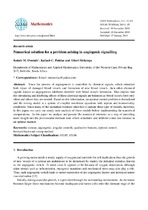| dc.contributor.author | Kolade, Owolabi | |
| dc.contributor.author | Kailash, Patidar | |
| dc.contributor.author | Shikongo, Albert | |
| dc.date.accessioned | 2020-06-04T15:31:11Z | |
| dc.date.available | 2020-06-04T15:31:11Z | |
| dc.date.issued | 2019 | |
| dc.identifier.citation | Kolade, M. 2019. Numerical solution for a problem arising in angiogenic signalling. AIMS Mathematics, 4(1): 43-63. doi: 10.3934/Math.2019.1.43. | en_US |
| dc.identifier.uri | http://dx.doi.org/10.3934/Math.2019.1.43 | |
| dc.identifier.uri | http://hdl.handle.net/10566/5222 | |
| dc.description.abstract | Since the process of angiogenesis is controlled by chemical signals, which stimulate
both repair of damaged blood vessels and formation of new blood vessels, then other chemical
signals known as angiogenesis inhibitors interfere with blood vessels formation. This implies that
the stimulating and inhibiting e ects of these chemical signals are balanced as blood vessels form only
when and where they are needed. Based on this information, an optimal control problem is formulated
and the arising model is a system of coupled non-linear equations with adjoint and transversality
conditions. Since many of the numerical methods often fail to capture these type of models, therefore,
in this paper, we carry out steady state analysis of these models before implementing the numerical
computations. In this paper we analyze and present the numerical estimates as a way of providing
more insight into the postvascular dormant state where stimulator and inhibitor come into balance in
an optimal manner. | en_US |
| dc.language.iso | en | en_US |
| dc.publisher | American Institute of Mathematical Sciences | en_US |
| dc.subject | Angiogenics | en_US |
| dc.subject | Numerical methods | en_US |
| dc.subject | Tumour | en_US |
| dc.subject | Mathematical modelling | en_US |
| dc.title | Numerical solution for a problem arising in angiogenic signalling | en_US |
| dc.type | Article | en_US |

